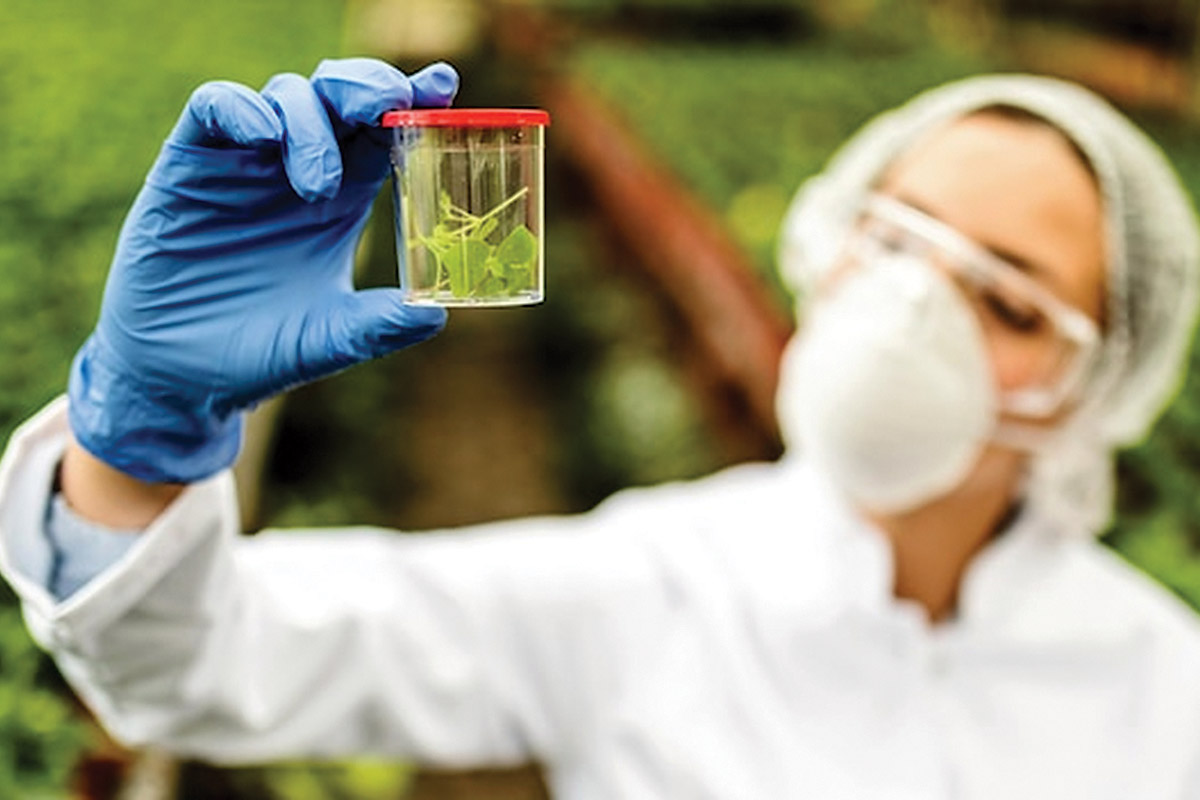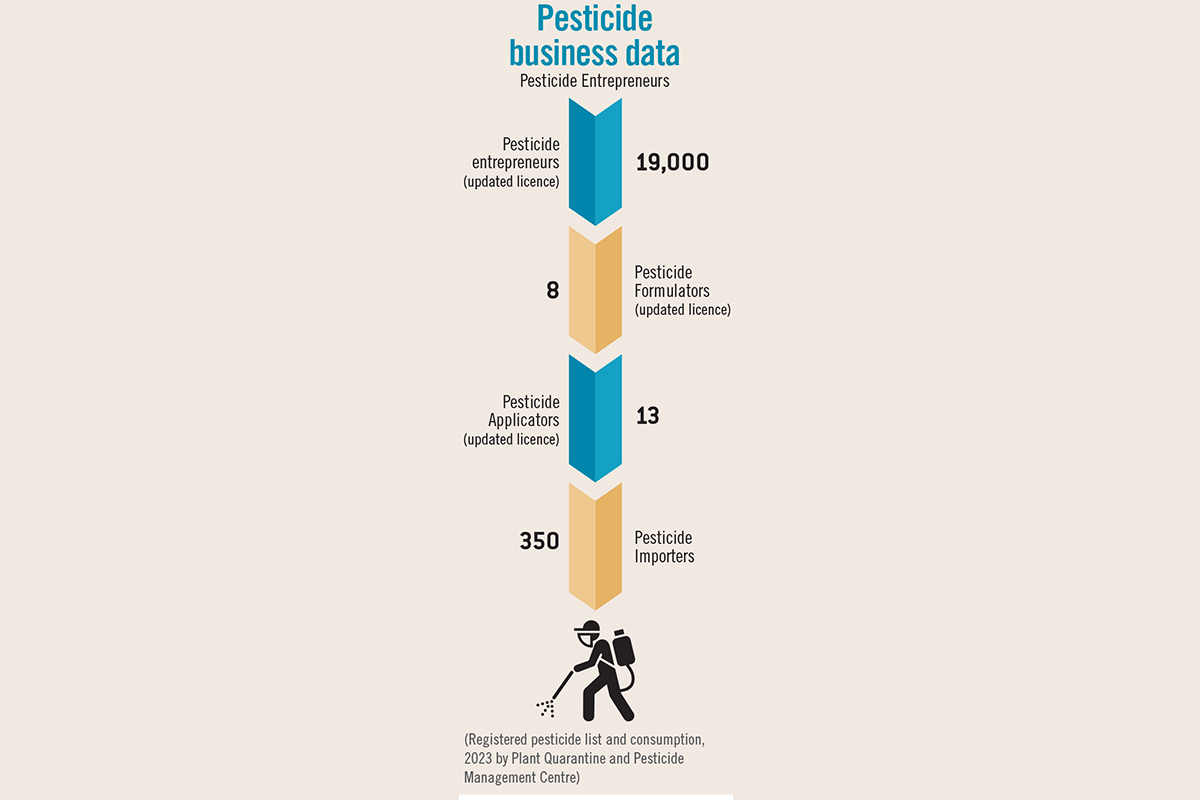
The regulation and control of pesticide use is a widely discussed topic among policymakers. However, the import and use of pesticides remain rampant. An examination of data released by the Department of Customs reveals that the country imported 30,152.87 quintals of pesticides valued at Rs 1.19 billion in the first nine months of the current Fiscal Year 2024/25. (See Table 1)
Weak surveillance and monitoring
Nepal imports vegetables and fruits from India and other markets without adhering to proper quarantine protocols. Although a provision for quarantine checks was introduced earlier in 2019, the government subsequently reversed this decision, citing a lack of laboratory infrastructure at the checkpoints. The justification provided for withdrawing the decision was that vegetables and fruits are perishable, and obtaining lab test certificates from internationally accredited laboratories, which required sending samples, could take as long as a week.
Conversely, trucks and containers transporting ginger, cardamom and other perishable agricultural commodities were stranded for weeks at checkpoints awaiting entry into the Indian market. India does not permit Nepali agricultural products to enter its market without valid quarantine certificates.
Consequently, the reciprocity of trade is undermined by the more powerful nation. Purushottam Ojha, Former Commerce Secretary, commented, "Nepal and India should forge a consensus on a mutual recognition agreement for their lab certifications to resolve these issues."
Restriction and protocols
The Plant Quarantine and Pesticide Management Centre, operating under the Ministry of Agriculture and Livestock Development, has established various protocols concerning pesticide use in vegetables and plants. Based on the World Health Organisation classification, it has restricted the import, transport and distribution of certain pesticides deemed hazardous to human health. The WHO categorises pesticides as extremely, highly, moderately, slightly hazardous, and unlikely to present acute hazard or non-hazardous.
Table 1: Imports of pesticides and poisons
|
Products |
Unit |
Quantity |
Imports (Rs in '000) |
Import Revenue (Rs in '000) |
|
Products for killing mosquito, cockroach and like household insects |
Kg |
812,930 |
555,761 |
136,128 |
|
Pesticides used in crops and vegetables |
Kg |
3,015,287 |
1,192,818 |
179,734 |
|
Fungicides |
Kg |
1,280,012 |
601,989 |
89,464 |
|
Herbicides |
Kg |
557,935 |
322,317 |
47,366 |
|
Antisprouting Products and Plant Growth Regulator |
Kg |
4,041,925 |
464,843 |
113,731 |
|
Rat poison |
Kg |
47,993 |
30,971 |
5,405 |
|
Others – Rodenticides |
Kg |
194,122 |
75,563 |
14,076 |
(Source: Import of pesticides and other poisons in nine months, mid-July 2024 to mid-April, 2025 by Department of Customs)
Restricted pesticides
Aldrin, BHC, Chlordane, Dieldrin, DDT, Endrin, Heptachlor, Lindane, Organic Mercury Fungicides, Mirex, Phosphamidon, Organo mercury chloride, Toxaphene, Monocrotophos, Methyl Parathion, Endosulfan, Phorate, Benomyl, Carbofuran, Triozophos, Dichlorovos, Carbosulfan, Dicofol, Aluminium Phosphide (56%)-3-gram tablet.
(Source: Plant Quarantine and Pesticide Management Centre)
Despite the Plant Quarantine and Pesticide Management Centre's restrictions on hazardous pesticide use, such pesticides are being transported illegally into Nepal due to the open and porous border with India. This situation is challenging to manage without strict control over illegal and informal trade across the border.
Prakash Paudel, Information Officer at the Plant Quarantine and Pesticide Management Centre, has stated that the centre has developed protocols for pesticide use and is actively raising awareness regarding non-hazardous pest control methods and the safe application of permitted pesticides. According to Paudel, "The centre has been regularly monitoring and conducting surveys in commercial production areas."
He further added, "Alongside mass awareness campaigns, on-site training and demonstrations are equally vital for promoting safety measures throughout all stages of pesticide handling. Farmers often possess limited knowledge about pesticides, and pesticide regulations have not been effectively enforced."
The government recently introduced the Pesticide Management Regulation 2024 which advocates for an Integrated Pest Management (IPM) approach. To benefit farmers, pesticide dealers and other concerned stakeholders, the regulation and its administration by government agencies need to be implemented on a large scale.
A recent survey conducted by the Plant Quarantine and Pesticide Management Centre highlighted that many farmers are unaware of the long-term and indirect effects of pesticides on food production systems, the health of farmers and consumers, and the environment. This underscores the urgent need for strategies to minimise pesticide use and misuse. Furthermore, those involved in commercial production were found to be less diligent in minimising the use of hazardous pesticides.
The survey emphasised the necessity of awareness campaigns, education and training for farmers on pesticide use, as well as an effective monitoring programme for pesticide residues in vegetables. It also strongly recommended research and development into bio-pesticides and eco-friendly measures to reduce the use of hazardous pesticides.
Conversely, weak surveillance and monitoring, coupled with a lack of political commitment to control the import of vegetables and fruits and the movement of locally produced goods from commercial areas without proper quarantine checks, are significantly jeopardising consumer health.

Degradation of soil and long-term impacts
Experts have cautioned that the overuse of pesticides can degrade soil quality over time. Pesticide application can eliminate beneficial soil organisms such as bacteria, fungi, earthworms and insects which are crucial for soil fertility and nutrient cycling through aeration and water retention, contributing to softer and more fertile soil. In some instances, excessive use can harm soil quality by increasing acidity due to the interaction of pesticides with other chemicals.
The government permits registered importers to bring in various types of pesticides, including insecticides, fungicides, herbicides, acaricides, rodenticides, nematicides, molluscides, bactericides, and botanical and bio-pesticides, which are considered less hazardous. Regrettably, the application of even these pesticides can kill beneficial soil organisms and degrade soil quality, leading to a loss of fertility over time.
Bio-pesticide: amicable solution for organic farming
Several municipalities and provinces have been promoting organic farming and pest-free products. Bio-pesticides align with organic farming standards, aiding in pest control without the use of synthetic chemicals. Simultaneously, they help preserve soil fertility and biodiversity and prevent the contamination of water sources.
According to Uttam Kumar Bhattari, Former Secretary of the Ministry of Agriculture and Livestock Development, bio-pesticides decompose rapidly, leaving no harmful residues, which is crucial for Nepal’s delicate mountain ecosystems. He stated, "Nepal should promote cost-effective and transformative solutions for organic farming to achieve sustainable agriculture and address the public health issues arising from the consumption of vegetables and fruits with high levels of pesticide residue."
Bio-pesticides can be produced domestically using local raw materials and local innovations and technologies. For example, microbial pesticides can be developed from bacteria, fungi, and viruses; botanical pesticides from plant extracts like neem and pyrethrum; and biochemical pesticides from pheromones and enzymes.
In conclusion, while Nepal grapples with the widespread import and use of both regulated and illicit pesticides, posing risks to public health, trade relations, and environmental sustainability, a path forward exists. Strengthening border controls to curb the illegal influx of hazardous substances, coupled with rigorous enforcement of the newly introduced Pesticide Management Regulation, are crucial first steps.
READ ALSO:




-1761806697.jpg)
-1758006240.jpg)
-1752225714.jpg)